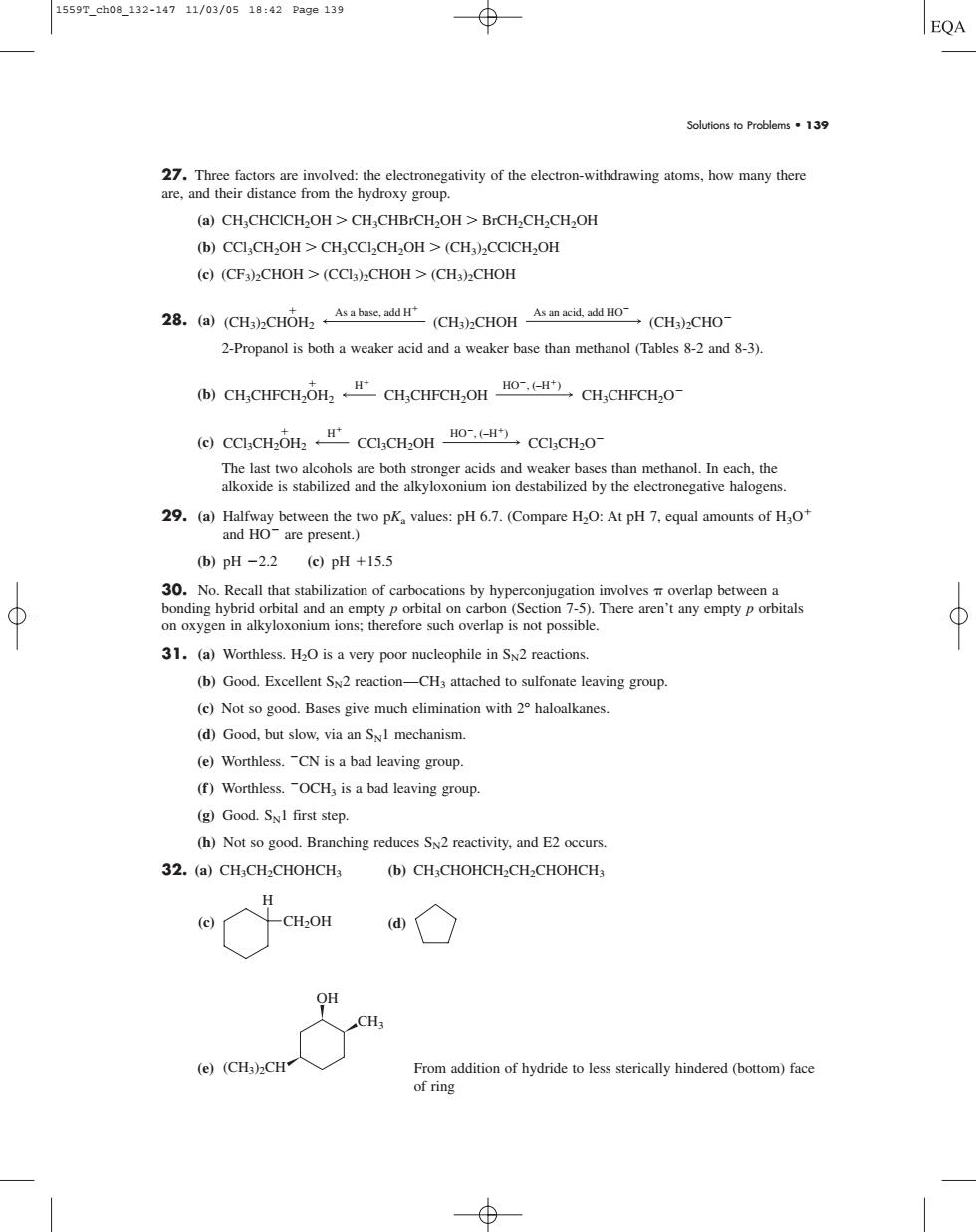正在加载图片...

1559Tch08132-14711/03/0518:42Page139 EQA Solutions to Problems139 27.Three factors are involved:the elctrogativity of the elctron-withdrawing atoms how many there are,and their distance from the hydroxy group. (a)CH CHCICH OH>CH CHBICHOH>BrCH,CH,CH OH (b)CCl,CH,OH>CH,CCICH,OH>(CH)CCICH,OH (e)(CF3)2CHOH>(CCl)CHOH>(CH)CHOH 28.()(CH,)CHOH (CHs)CHOHs (CH3)CHO- 2-Propanol is botha weaker acid and a weaker base than methanol (Tables8-2 and 8-3) ()CH.CHFCHOHCH,CHFCH,OH CH.CHFCHO- 29.(a)Halfwa b)pH-2.2(cpH+15.5 ⊕ on oxygen in alkyloxonium ions:therefore such overlap is not possible. 31.(a)Worthless.H is a very poor nucleophile in S2 reactions (b)Good.Excellent Sx2 reaction-CH,attached to sulfonate leaving group (c)Not so good.Bases give much elimination with 2 haloalkanes. (d)Good,but slow,viaan S mechanism. (e)Worthless.-CN isa bad leaving group. (f)Worthless.OCH,isa bad leaving group (g)Good.S first step. (h)Not so good.Branching reduces S2 reactivity.and E2occurs. 32.(a)CH,CH:CHOHCH (b)CH,CHOHCH-CH.CHOHCHs -CH2OH CH; (e)(CH3)CH From addition of hydride to less sterically hindered (bottom)face of ringSolutions to Problems • 139 27. Three factors are involved: the electronegativity of the electron-withdrawing atoms, how many there are, and their distance from the hydroxy group. (a) CH3CHClCH2OH CH3CHBrCH2OH BrCH2CH2CH2OH (b) CCl3CH2OH CH3CCl2CH2OH (CH3)2CClCH2OH (c) (CF3)2CHOH (CCl3)2CHOH (CH3)2CHOH 28. (a) 2-Propanol is both a weaker acid and a weaker base than methanol (Tables 8-2 and 8-3). (b) (c) The last two alcohols are both stronger acids and weaker bases than methanol. In each, the alkoxide is stabilized and the alkyloxonium ion destabilized by the electronegative halogens. 29. (a) Halfway between the two pKa values: pH 6.7. (Compare H2O: At pH 7, equal amounts of H3O and HO are present.) (b) pH 2.2 (c) pH 15.5 30. No. Recall that stabilization of carbocations by hyperconjugation involves overlap between a bonding hybrid orbital and an empty p orbital on carbon (Section 7-5). There aren’t any empty p orbitals on oxygen in alkyloxonium ions; therefore such overlap is not possible. 31. (a) Worthless. H2O is a very poor nucleophile in SN2 reactions. (b) Good. Excellent SN2 reaction—CH3 attached to sulfonate leaving group. (c) Not so good. Bases give much elimination with 2° haloalkanes. (d) Good, but slow, via an SN1 mechanism. (e) Worthless. CN is a bad leaving group. (f ) Worthless. OCH3 is a bad leaving group. (g) Good. SN1 first step. (h) Not so good. Branching reduces SN2 reactivity, and E2 occurs. 32. (a) CH3CH2CHOHCH3 (b) CH3CHOHCH2CH2CHOHCH3 (c) (d) (e) From addition of hydride to less sterically hindered (bottom) face of ring (CH3)2CH CH3 OH H CH2OH CCl3CH2OH2 CCl3CH2OH CCl3CH2O H HO, (–H ) CH3CHFCH2OH2 CH3CHFCH2OH CH3CHFCH2O H HO, (–H ) (CH3)2CHOH2 (CH3)2CHOH (CH3)2CHO As a base, add H As an acid, add HO 1559T_ch08_132-147 11/03/05 18:42 Page 139��������������������